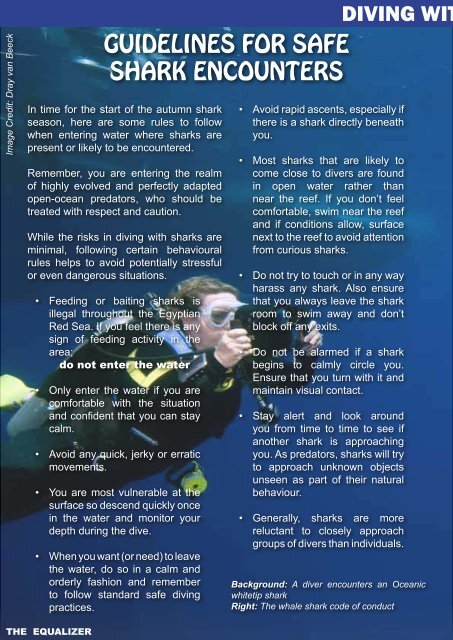FREE** **Enter our photo contest to win a mini-safari trip - aziab media
FREE** **Enter our photo contest to win a mini-safari trip - aziab media
FREE** **Enter our photo contest to win a mini-safari trip - aziab media
You also want an ePaper? Increase the reach of your titles
YUMPU automatically turns print PDFs into web optimized ePapers that Google loves.
Image Credit: Dray van Beeck<br />
DIVING WITH SHARKS<br />
GUIDELINES FOR SAFE<br />
SHARK ENCOUNTERS<br />
In time for the start of the autumn shark<br />
season, here are some rules <strong>to</strong> follow<br />
when entering water where sharks are<br />
present or likely <strong>to</strong> be encountered.<br />
Remember, you are entering the realm<br />
of highly evolved and perfectly adapted<br />
open-ocean preda<strong>to</strong>rs, who should be<br />
treated with respect and caution.<br />
While the risks in diving with sharks are<br />
<strong>mini</strong>mal, follo<strong>win</strong>g certain behavi<strong>our</strong>al<br />
rules helps <strong>to</strong> avoid potentially stressful<br />
or even dangerous situations.<br />
• Feeding or baiting sharks is<br />
illegal throughout the Egyptian<br />
Red Sea. If you feel there is any<br />
sign of feeding activity in the<br />
area;<br />
do not enter the water<br />
• Only enter the water if you are<br />
comfortable with the situation<br />
and confident that you can stay<br />
calm.<br />
• Avoid any quick, jerky or erratic<br />
movements.<br />
• You are most vulnerable at the<br />
surface so descend quickly once<br />
in the water and moni<strong>to</strong>r y<strong>our</strong><br />
depth during the dive.<br />
• When you want (or need) <strong>to</strong> leave<br />
the water, do so in a calm and<br />
orderly fashion and remember<br />
<strong>to</strong> follow standard safe diving<br />
practices.<br />
• Avoid rapid ascents, especially if<br />
there is a shark directly beneath<br />
you.<br />
• Most sharks that are likely <strong>to</strong><br />
come close <strong>to</strong> divers are found<br />
in open water rather than<br />
near the reef. If you don’t feel<br />
comfortable, swim near the reef<br />
and if conditions allow, surface<br />
next <strong>to</strong> the reef <strong>to</strong> avoid attention<br />
from curious sharks.<br />
• Do not try <strong>to</strong> <strong>to</strong>uch or in any way<br />
harass any shark. Also ensure<br />
that you always leave the shark<br />
room <strong>to</strong> swim away and don’t<br />
block off any exits.<br />
• Do not be alarmed if a shark<br />
begins <strong>to</strong> calmly circle you.<br />
Ensure that you turn with it and<br />
maintain visual contact.<br />
• Stay alert and look around<br />
you from time <strong>to</strong> time <strong>to</strong> see if<br />
another shark is approaching<br />
you. As preda<strong>to</strong>rs, sharks will try<br />
<strong>to</strong> approach unknown objects<br />
unseen as part of their natural<br />
behavi<strong>our</strong>.<br />
• Generally, sharks are more<br />
reluctant <strong>to</strong> closely approach<br />
groups of divers than individuals.<br />
Background: A diver encounters an Oceanic<br />
whitetip shark<br />
Right: The whale shark code of conduct<br />
Whale Sharks are passive creatures and can be agitated by aggressive behavi<strong>our</strong><br />
such as being <strong>to</strong>uched, or chased. It is as much a diver’s responsibility as anyone’s<br />
<strong>to</strong> ensure the survival of Whale Sharks for future generations. This means causing<br />
<strong>mini</strong>mal disturbance <strong>to</strong> the sharks when approaching by boat or when diving. Although<br />
Whale Sharks are harmless, their sheer size makes it necessary <strong>to</strong> exercise caution<br />
around them, especially at the tail end.<br />
Divers need <strong>to</strong> be aware of any local regulations or pro<strong>to</strong>cols set by the dive organisation<br />
regarding behavi<strong>our</strong> around Whale Sharks before entering the water. Regardless<br />
of whether there are any regulations are in place, please follow these general<br />
guidelines developed and promoted by The Shark Trust, the Australian Department of<br />
Conservation and Land Management and PADI and the Project AWARE Foundation,<br />
both for y<strong>our</strong> own safety and for the safety of the Sharks.<br />
Swimmers and divers<br />
WHALE SHARK<br />
CODE OF CONDUCT<br />
reprinted c<strong>our</strong>tesy of The Shark Trust<br />
• Do not attempt <strong>to</strong> <strong>to</strong>uch, ride, or<br />
chase a Whale Shark<br />
• Do not restrict normal movement<br />
or behavi<strong>our</strong> of the Shark<br />
• Maintain a <strong>mini</strong>mum distance of 3<br />
metres from the Whale Shark<br />
• Do not undertake flash <strong>pho<strong>to</strong></strong>graphy<br />
• Do not use underwater mo<strong>to</strong>rised<br />
diver propulsions<br />
THE EQUALIZER Sep-Oct 2011





